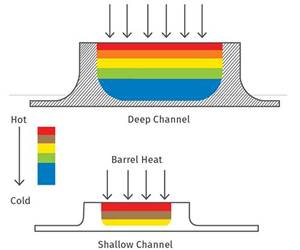Well, It Worked on Brand X
You need to give your designer a lot more data than that to make sure you get a screw that's right for you.
I see requests for screw designs or screw evaluations with essentially no other information than that which appears in the headline above. A screw is an important part of an extruder, but it is just that—a part. No matter what the screw design, or who your designer is, it cannot perform correctly without information about the surrounding parts of the extruder, what your process requirements are, and the characteristics of the polymer you will be processing.
What is the output of the screw design in the accompanying illustration? Even given all the dimensions, its output capacity is unknown until a lot more components are in place and a lot more information is available. Obviously, before a screw can do anything, it has to be enclosed in a close-fitting barrel, have a drive to rotate it with sufficient torque, heat to get the process started, and an apparatus to deliver polymer to the feed end. The differences in extruder hardware alone account for hundreds of screw designs. If the screw were a stand-alone device, only a few designs would be required—one for HIPs, one for PET, PC, and so forth.
To optimize screw performance, you first need to know what the performance target is in terms of output, melt temperature, head pressure, melt homogeneity, and stability. Those goals are compared against the available screw diameter, L/D, drive power, screw speed, polymer characteristics, and head pressure.
And there are many other considerations: Is the screw vented? Does it have a grooved feed throat, supplemental feed device, melt pump? What is being fed to the screw—pellets, powder, flake, or fluff—and how? The form of the feed material has to be considered to determine whether the screw can match the target output. Is the feed opening sufficiently large, and are there any restrictions prior to the throat, such as stuffers, crammers or feeders? Is screw cooling required? If there are additives going directly into the feed throat, what is their effect on feeding? For example, heavy mineral fillers often must be starve-fed to prevent them from segregating, which in turn affects the output and melting.
Under what level of head pressure is the screw going to operate? Head pressure affects output, melt temperature, and melt homogeneity. How do you estimate the head pressure on a new application without a melt pump? What is the desired melt temperature? The screw may be intended primarily for LDPE blown film or for LDPE extrusion coating; these are essentially the same polymer, but they have two widely different melt temperatures, requiring two different screw designs.
These are only a few of the considerations that have to be evaluated before a screw design is even started. Many years ago I tried to make a data sheet that would cover all of the considerations that have to go into a screw design but gave up when it exceeded 50 items. I figured no processor would ever take the time to fill it out. That leaves most of the research to the screw designer.
Once the design is under way, what type of screw would give the best result: conventional flighted design, barrier design, wave-type screw, or a decompression design? Does the screw need a supplemental mixer for distributing additives, blending different polymers, or to complete melting?
With those considerations resolved, the properties of the polymer are to be considered next. The physical, thermal, and rheological properties for that particular resin must be applied to each section of the screw to get a balanced design that will meet the target performance. This data is not always easily available and often requires hours of research. Occasionally the target cannot be met and must be reduced or the extruder changed in some way.
Without every bit of this information the design cannot be optimized for the application and will contain a lot of guesswork. Often the research is limited to, “It worked for Brand X, it will probably work for Brand Y.” Be cautious of screw designs for which no information is requested except for the screw’s envelope dimensions and polymer type. You’ll be getting someone else’s screw.
Related Content
Single vs. Twin-Screw Extruders: Why Mixing is Different
There have been many attempts to provide twin-screw-like mixing in singles, but except at very limited outputs none have been adequate. The odds of future success are long due to the inherent differences in the equipment types.
Read MoreThe Importance of Barrel Heat and Melt Temperature
Barrel temperature may impact melting in the case of very small extruders running very slowly. Otherwise, melting is mainly the result of shear heating of the polymer.
Read MoreHow To Identify Resin Degradation in Single-Screw Extruders
Degradation can occur in many single-screw extrusion operations, and typically occurs due to minor design flaws in the screw. Here is how to track it down.
Read MoreShredding Thin Film: How to Do It Right
While many processors recoil at this task, a little know-how in shredding equipment, processing, and maintenance should add the necessary confidence.
Read MoreRead Next
For PLASTICS' CEO Seaholm, NPE to Shine Light on Sustainability Successes
With advocacy, communication and sustainability as three main pillars, Seaholm leads a trade association to NPE that ‘is more active today than we have ever been.’
Read MoreLead the Conversation, Change the Conversation
Coverage of single-use plastics can be both misleading and demoralizing. Here are 10 tips for changing the perception of the plastics industry at your company and in your community.
Read MoreSee Recyclers Close the Loop on Trade Show Production Scrap at NPE2024
A collaboration between show organizer PLASTICS, recycler CPR and size reduction experts WEIMA and Conair recovered and recycled all production scrap at NPE2024.
Read More.jpg;width=70;height=70;mode=crop)













